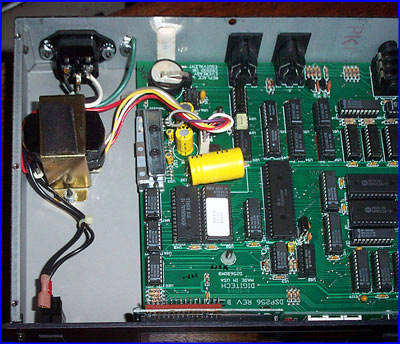The HAMMOND ORGAN
North Suburban HAMMOND ORGAN Service

Figure 1. The interior of a typical stand-alone digital effects processor. Notice that its appearance is very similar to that of many other electronic devices, and indeed, there is far more similarity between disparate electronic devices than you might initially realize. Capacitors, resistors, IC chips, power supplies switches and input and output connections are all similar. The basic difference between devices is in their final applications.
Here we look inside a digital signal processor, and this view shows that its general appearance is a lot like that of a computer or some other modern electronic device. Indeed, there is much similarity in many disparate electronic devices. Many of the components are the same regardless of what an electronic device is supposed to do. The differences lie more in what the intended purpose of the device is, which determines how these similar components will work with each other as a whole system.
Among these are predelay, or the amount of time that elapses until the first significant reverb is heard; subsequent delay, or the time before the main "body" of the reverb sounds. The reverb decay time is also adjustable which of course is how long the reverb should last. Also adjustable are the amounts of high and low frequency damping, that is, should the higher frequencies of reverb die out sooner than the lower ones, or should the low frequencies disappear first. This makes it possible to differentiate between, for example, a room with lots of carpeting and draperies, or a room with lots of hard, reflective surfaces. Still another adjustable parameter is "envelopment" or how the reverb relates to your location in the virtual reverberant environment. For example, does the reverb surround you from all sides, or does it come from a more distant location? All of these characteristics can be varied, and depending on the character of the music, the right acoustical environment can contribute a significant amount of audible information to enhance your enjoyment of the program you are hearing.

Figure 2. The remaining interior of the dsp. A whole studio full of many separate analog devices including possibly even special rooms to act as echo or reverberation chambers would be needed 35 years ago to duplicate all the effects that this one single device can do. Truly, the progress made in electronics is absolutely amazing. In producing reverberation, for example, this device lets the user tweak all parameters that influence the final reverb output.
From the early Hammond spring reverb units with the springs in tubes of oil to the modern DSP represents a tremendous amount of electro-musical engineering accomplishment. With a device such as the unit above, the simple changing of certain parameters makes almost any conceivable type of acoustic environment possible, from the effect of a tiled bathroom to being under a large stone-arch bridge.
As with so many related devices, the effects of a digital effects processor should be used carefully and the effect should be subtle. You should not, with the exception of certain novelty effects, become aware of the reverb in any music. It should just be there in the background where it adds its enhancement without intruding.
Previous Page Page 7.